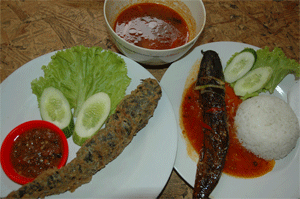A variety of creation on processed food of catfish-based makes it certain for catfish to become a promising business commodity. So many creativities and courage to try new different things keeps on rolling. The efforts to adorn the catfish physical appearance, eliminating the impression of creepy, dark, and snake-like appearance, becomes a special challenge. The purpose is to improve attractiveness for the consumers.
It is performed, among others, by Rangga Umara, in developing a modern culinary business of “Pecel Lele Lela” in Jakarta region. This food court presents various interesting menu on catfish base. Using a creativity to combine catfish meal with lifestyle, the business carried out since 2006 has been developed to more than 20 branches. Each month, he can enjoy a turnover of IDR 1.2 billion with a profit of 25-30%. According to Rangga, the prestige of catfish can be raised. In his court, there are processed menu of fried catfish, catfish with Padang sauce, original catfish and fillet catfish as its top menu, Tomyam catfish and teriyaki catfish as additional menu. In fact, Rangga admitted, he is preparing catfish steak and catfish burger.
Marsini’s business is another example. The large-sized rejected catfish known as “bantongan,” which is usually not marketable, becomes the blessing for the woman from Boyolali, Central Java. She develops processing business by transforming the fish into snacks in the forms of chips and shredded meat called abon. The business started in 2007 has a turnover of approximately IDR 10 million per month. “At first, the business was initiated to find a way to make use of the catfish cultivation not marketable for consumption due to its oversize,” explained Marsini. In a week, she can spend 200 kg of fresh catfish for processing. Such ingredient is converted into 140 kg of chips and 60 kg of abon. She takes advantage of her catfish cultivation having been carried out since 1998 with a capacity of 20 thousand catfishes in 50 pools.
Meanwhile, Center for Chemical Process and Technology Development (BPPTK) of the Indonesian Science Institution (LIPI) Gunungkidul develops canned catfish mangut. The Javanese traditional processed food, combined with such packing technology, is the result of a 3-years research. At present, BPPTIK-LIPI Gunungkidul has been only able to produce an average of 1000 cans of catfish mangut per month. Each can contains 1 piece of catfish (without the head and tail) and 1 kg of catfish may produce 6-7 cans of catfish mangut. “With this innovation, catfish can be sold not only in fish markets, diners, or restaurants. It can be displayed on regular food racks and is equal to other products of modern food industry,” revealed the Head of Program and Cooperation Section of BPPTK-LIPI Gunungkidul, Hardi Julendra.
Retrieved from: TROBOS (01 June 2010)
Retrieved from: TROBOS (01 June 2010)


No comments:
Post a Comment